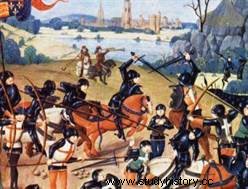 The Battle of Agincourt took place on October 25, 1415 near the village of Agincourt, in Pas-de-Calais, and opposed the French army to the English army of King Henry V. It is one of the most famous of the Hundred Years War between France and England (1337-1453). The French chivalry experienced its greatest defeat there against the English. With the death of the ideal of chivalrous warfare, this battle opens an uncertain era that threatens the very existence of France at the time. It also marks a turning point in the art of war in the Middle Ages, demonstrating the superiority of infantry over the heavy cavalry of the time.
The Battle of Agincourt took place on October 25, 1415 near the village of Agincourt, in Pas-de-Calais, and opposed the French army to the English army of King Henry V. It is one of the most famous of the Hundred Years War between France and England (1337-1453). The French chivalry experienced its greatest defeat there against the English. With the death of the ideal of chivalrous warfare, this battle opens an uncertain era that threatens the very existence of France at the time. It also marks a turning point in the art of war in the Middle Ages, demonstrating the superiority of infantry over the heavy cavalry of the time.
The context of the battle of Agincourt
France has been torn by conflict between the Armagnacs and the Burgundians since the assassination of Louis d'Orléans in 1407, on the orders of Jean sans Peur. The struggle culminates in violence with the Cabochian episode of 1413. The same year, following his failure in Paris, the Duke of Burgundy negotiates with the English. The previous year, it was the Armagnacs who had asked for help, provoking an English ride despite an agreement in extremis between Armagnacs and Burgundians in Auxerre...
The English are not in a much more enviable situation, also torn apart by a war between King Plantagenet Richard II and Duke Henry of Lancaster, his cousin. The latter, supported by Parliament, finally won and was appointed as the new king in 1399. However, he saw his own son rebel against him in 1411. It was a failure, but that did not prevent the young Henri V to succeed his father when he died in 1413. The legitimacy of the new English king being faltering, he had to face conspiracies. To calm them down, Henry V then decided to relaunch the war with France. He obviously learned of the divisions due to the civil war, and sees with a good eye the proposals of the Burgundians.
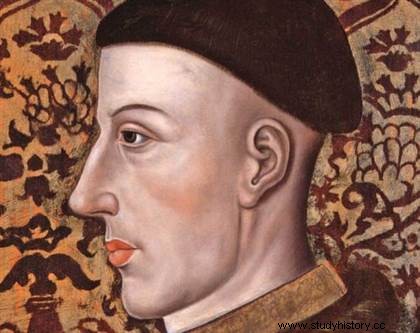 In 1414, he resumed the claims of Edward III and demanded all the fiefs lost by the English since…the King of France Philippe Auguste! His excessive claims were rejected, both by the Armagnacs and the Burgundians. So this is war. We do not know, however, the purpose of King Henry V of England when he landed in Normandy in August 1415, with ten thousand men transported by one thousand five hundred ships. If the army is large, it is however insufficient for an invasion, and the timing is inopportune for a long campaign. After taking Harfleur, the King of England began a classic ride towards Calais. The French decided to counter-attack and cut his road in Artois, at Agincourt, on October 25, 1415.
In 1414, he resumed the claims of Edward III and demanded all the fiefs lost by the English since…the King of France Philippe Auguste! His excessive claims were rejected, both by the Armagnacs and the Burgundians. So this is war. We do not know, however, the purpose of King Henry V of England when he landed in Normandy in August 1415, with ten thousand men transported by one thousand five hundred ships. If the army is large, it is however insufficient for an invasion, and the timing is inopportune for a long campaign. After taking Harfleur, the King of England began a classic ride towards Calais. The French decided to counter-attack and cut his road in Artois, at Agincourt, on October 25, 1415.
The forces at Agincourt
The French army is led by the constable armagnac Charles I d'Albret who, due to the troubled context, decided to do without the Burgundian troops of Jean sans Peur. This therefore orders the nobility of Picardy not to join the host. The Duke of Brittany, still torn between the two kings, is also absent. The princes present, for their part, did not agree on the strategy to adopt, the oldest like the Duke of Berry advocating caution, the youngest like the Duke Charles of Orléans attacking him. Jean de Berry nevertheless obtains that the king and the dauphin remain in Rouen.
The army finally assembled is made up of nearly twenty thousand men (some say twenty-five thousand), mostly cavalry. The constable would have refused the help of Genoese crossbowmen, judging his troops largely sufficient. It is true that opposite, Henri V lines up about seven thousand men, including a thousand knights and especially five thousand archers. The English troops are tired by the campaign started several months earlier. The French army, which has chosen the place of the battle, is therefore very confident...
The battlefield
It's hard to explain the French mistakes even before the battle of Agincourt! The choice of location, and even more the placement of the troops, are catastrophic. The French army, three more numerous than the enemy, regrouped in a restricted space located between two forests, which annihilates its numerical advantage.
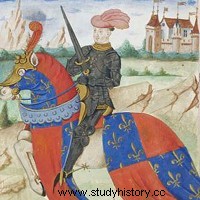 The nobles believe they have the right to be in the front line to crush the English themselves; they thus leave behind them more experienced fighters, crowded into about twenty ranks, and squires for the reserve. The wings are composed of cavalry intended to attack Henry's archers from the start of the battle. The lack of space pushes them to deprive themselves of archers and crossbowmen, but the constable considers that he will not need them anyway... The command of the army is uncertain, divided between Charles d'Albret and dukes like Orléans or Alençon.
The nobles believe they have the right to be in the front line to crush the English themselves; they thus leave behind them more experienced fighters, crowded into about twenty ranks, and squires for the reserve. The wings are composed of cavalry intended to attack Henry's archers from the start of the battle. The lack of space pushes them to deprive themselves of archers and crossbowmen, but the constable considers that he will not need them anyway... The command of the army is uncertain, divided between Charles d'Albret and dukes like Orléans or Alençon.
The weather conditions are also not ideal for a battle, and even more so for a cavalry charge. It keeps raining, and the soldiers spend the night in their combat gear. The next day is an indescribable quagmire! Henry V has less choice, and he arranges his army in a classic way:men-at-arms in the center; on the wings and a little forward, the archers in a conical formation. The King of England has not forgotten the lessons of Crécy.
The Battle of Agincourt
After a few final formal negotiations, the battle begins around ten o'clock on October 25, 1415. Henry V advances his archers, who are immediately charged. But the mud slowed down the heavy French steeds, which then suffered several volleys of arrows. The bodies pile up, forming a rampart in front of the following fighters, trapped by the geography of the terrain! The French knights still manage to make contact, but without the benefit of the charge; they put in spite of everything in difficulty the English men-at-arms. The King of England, threatened directly by the Constable, then dragged his archers onto the enemy flanks, and the quarry resumed, the English archers fighting in turn in hand-to-hand combat. Already, many French lords surrender. The French army attempts a second charge, but encounters the withdrawal of the first, adding to the chaos! The battle hasn't started for an hour...
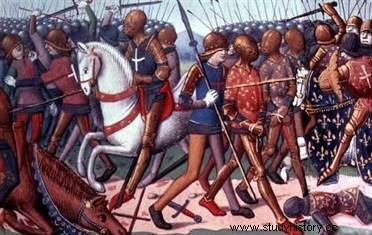 The worst is yet to come though. A rumor bursts in the English rows:the French would have counter-attacked on their backs. It is in fact only an attempt at a counter-offensive, but Henry V, who fears the arrival of Jean sans Peur, orders the massacre of most of the captives (despite the protest of the archers, who want ransoms ), before leaving the battlefield! Most of the French army did not even have time to come into contact.
The worst is yet to come though. A rumor bursts in the English rows:the French would have counter-attacked on their backs. It is in fact only an attempt at a counter-offensive, but Henry V, who fears the arrival of Jean sans Peur, orders the massacre of most of the captives (despite the protest of the archers, who want ransoms ), before leaving the battlefield! Most of the French army did not even have time to come into contact.
At the end of the afternoon, after the passage of corpse looters and scavengers, on the French side, approximately one thousand five hundred knights were killed, including the Dukes of Brabant , Alençon, Bar, the Counts of Nevers, Dammartin, Vaucourt (and many others), but also the Constable of Albret himself! To this must be added more than three thousand “other” dead, including all the bailiffs of the region, responsible until then for raising the troops. The number – and name – of prisoners is even worse:the Dukes of Orléans and Bourbon, Marshal Boucicaut, Charles d'Artois or the Count of Harcourt. Substantial ransoms in perspective. The English count only between three and five hundred dead, including a dozen knights, including the Duke of York.
On both sides, God is made the judge of the Battle of Agincourt, which adds to its importance, even beyond its ultimately minimal strategic impact. Indeed, the victory did not prevent Henry V from returning to sea for England. The consequences are visible afterwards.
Serious consequences
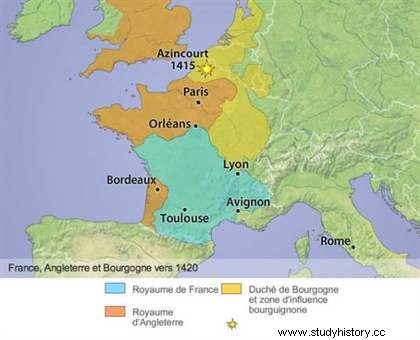 The debacle first brought the few French princes still alive, including the Duke of Anjou, to sign separate peaces, even agreements with the English. The defeat worsens the civil war, the Armagnac ranks having been the most affected, and the absent Jean sans Peur again negotiating with the enemy. The feeling that dominates among the French is that of abandonment by God, the latter punishing the princes with fratricidal war and the humiliation of Agincourt.
The debacle first brought the few French princes still alive, including the Duke of Anjou, to sign separate peaces, even agreements with the English. The defeat worsens the civil war, the Armagnac ranks having been the most affected, and the absent Jean sans Peur again negotiating with the enemy. The feeling that dominates among the French is that of abandonment by God, the latter punishing the princes with fratricidal war and the humiliation of Agincourt.
The impact of this October 25, 1415 is therefore more political and psychological than military and strategic. The Treaty of Troyes in 1420, and the partition of France, would probably not have taken place without Agincourt. On the other hand, despite the tactical lesson, we cannot say that this rout completely marks the end of the cavalry battle, or even of the chivalrous ideal. The French chivalry will have the opportunity to take some revenge, as in Castillon (1453), despite an evolution of the armies and the appearance of artillery. In Marignan, in 1515, the charge of François I will be inspired by this chivalrous ideal.
For the English, the battle of "Agincourt" will remain among one of the most glorious, taken as a model by both Henry VIII and Shakespeare.
Bibliography
- G. Minois, The Hundred Years War, Tempus, 2008.
- C. Gauvard, France in the Middle Ages from the 5th to the 15th century, PUF, 2010.
- D. Paladilhe, The Battle of Agincourt - 1415, Academic Library Perrin, Collection For History, 2002.
